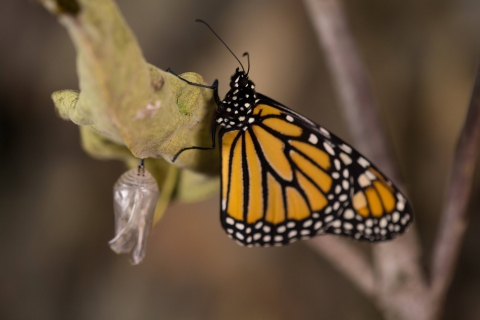Seasons of Wildlife
When visiting a wildlife refuge, guests are one step closer to wildlife! Throughout the year, visitors may catch glimpses of animals such as the prothonotary warbler, barred owl, red shouldered hawk, and more!
Fall: As the leaves fall around the island, you have a solid chance of spotting a great egret. This bird has a long S-curved neck and long legs for wading in the water. They are often found stalking their prey in shallow waters. “Who cooks for you”? The barred owl’s distinctive call sounds like a silly question. This owl is found year-round on the refuge in mixed forests of large trees. It preys on smaller birds and mammals and is preyed upon by the Great Horned Owl, which occasionally eats adults.
Winter: Snow’s not the only thing to look forward to here! The water may be super cold, but you can still manage to spot an osprey. This raptor often builds its nest on manmade structures like channel markers or duck blinds. It’s the only hawk on the continent that eats almost exclusively live fish! The red shouldered hawk oftens nests in tall trees and feeds on small mammals. These hawks return to the same nesting territory year after year, so there’s a slight chance you may see the same few if you return!
Spring: You have to have a quick eye to catch the peregrine falcon, this bird has a maximum speed of 240 mph and a terminal velocity of 300 km/h! Its speed classifies it as the world’s fastest bird! The peregrine falcon tends to nest and perch on skyscrapers, water towers, cliffs, power pylons, and other tall structures. It is one of the most widespread birds in the world and is found on every continent except Antarctica. You may also spot a Baltimore Oriole high in the trees searching for insects, flowers, and fruit.
Summer: During the summer, the beautiful Monarch Butterfly stops by to rest and feed on nectar before it leaves for the journey to its wintering grounds in Mexico! Visitors may also catch a glimpse of the famed prothonotary warbler! This small, yellow bird frequents the tidal swamp forest in the spring and summer. Listen for its "zweet zweet" call! If you’re lucky, you might also see the scarlet tanager. They sit high in the forest canopy, making them very difficult to spot. They primarily eat small insects, but you may be able to catch them snacking on berries!
Featured Species
Prothonotary Warbler
The prothonotary warbler is a small, brightly-colored yellow bird that frequents the tidal swamp forest in spring and summer. It is the only wood warbler in the eastern US that breeds in tree cavities. Although the neo-tropical migrant is small in stature, it has a loud, distinctive call. Visitors to the wetland boardwalk can listen for the zweet, zweet, zweet, zweet, zweet, zweet song all on one pitch. The species is declining over much of its breeding range (Florida to Wisconsin) but thriving at Presquile National Wildlife Refuge.
American Black Duck
The refuge provides important wintering habitat along the Atlantic Flyway for a number of waterfowl, specifically the American black duck. These birds utilize the tidal creeks and wetland pockets in fall and winter. Similar in size and genetically related to the mallard, the American black duck can be seen flying in groups, pairs, or solo. Overall populations of this species have declined by as much as 60 percent on the wintering grounds and thus have been identified as a species of management concern. The refuge has partnered with the Virginia Department of Wildlife Resources to further study the migration patterns of these ducks.
Monarch Butterfly
During the summer on Presquile National Wildlife Refuge insect life is extremely active. In grass and shrub habitats, particularly along trails, flying insects offer a variety of color and sound. The dragonflies and butterflies are some of the most ornate of these invertebrates. The monarch butterfly stops by the refuge to feed on nectar and rest as it embarks on an incredible journey from the mid-Atlantic states down to Mexico, their wintering grounds. Visitors that stand very still may become a brief landing site to one of these orange and black butterflies.
